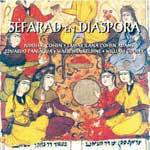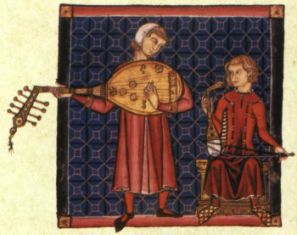


The year 1492 is very emblematic in Spain’s history. Three crucial events took place in that date during the reign of Isabel I Queen of Castile and Fernando II King of Aragón (the Catholic Monarchs): the first expedition they financed for Cristopher Columbus reached the end of its journey across the Atlantic ocean, their Christian army took over the last Muslim city of Granada (putting an end to the Reconquista), and they released the Alhambra Decree, which ordered the expulsion of practicing Jews from their kingdoms.
Thousands of Jewish families that refused to convert to the Catholic religion, were forced to embark on ships that took them in long journeys across the Mediterranean sea. They ended up establishing communities in places like today’s Morocco, Tunis, Egypt, Italy, Greece, Hungary, Bulgaria, the Balkans, Turkey,... The Iberian peninsula (Spain & Portugal) they had left behind was known in Hebrew language as Sefarad, but the tongue they brought with them to those new settlements was basically Castilian (Spanish) that had incorporated many words from the Hebraic vocabulary.
The last descendants from those Spanish-Jews still live in many of those places, although along the centuries they also moved to newer countries in the Americas or to Israel. Those Sephardic communities also developed their own musical tradition taking influences from all the places where they settled. Back in 2012, FolkWorld covered that in an interview with the Canadian ethnomusicologist Judith Cohen.[48]
This CD ‘Abre tu Puerta’, from the German band The Sephardics, is a 10 songs album, where all the tunes are quite popular in the traditional Spanish-Jewish repertoire. Nevertheless, they have taken these beautiful melodies and lyrics, to talentedly process them under more contemporary musical languages, such as Free Jazz and Avant-Garde Rock. The Sephardics are: Manuela Weichenrieder (voice, piano), Patrick Hengst (drum set), Martin Verborg (fiddle, sax), and Ludger Schmidt (cellos, acoustic & electronic).
The end result is a truly fascinating blend that swings between the sounds from the diaspora in Manuela’s charming lyrics, and the superb instrumental architecture built by Patrick, Martin and Ludger. There are a few videos in the band’s YouTube channel, also featuring Germán Díaz (hurdy-gurdy) and Diego Martín (drums), where already back in 2013, Manuela, Ludger and Ralf Kaupenjohann (accordion), displayed some of the bricks that would later become the solid walls for the construction of this album.
Spain’s current political situation seems to be resuscitating conflicts that are even much older than the Civil War (1936—1939), but among the many positive achievements from the last four decades there has been the interest to get back in contact with the culture and the peoples that were evicted from the country more than five centuries ago. In national politics, there has been a 2015 decree allowing thousands of foreign nationals of Sephardic background to also obtain Spanish citizenship. Culturally speaking there have been many Spanish folklorists that have gone back to learn about those who were forced to leave our country, but whose roots & legacy still preserve so much about our past. But ‘Abre tu Puerta’ (‘Open Your Door’) takes these traditional tunes into a new level.
This becomes clear since the first song, ‘La Rosa que Enflorece’ (‘The Rose that Blossoms’). Manuela starts playing the piano and later melismatically articulating the popular lyrics, while in parallel the drum set, the cello and the powerful saxophone gradually develop a creative musical landscape taking resources from Jazz and Progressive Rock. It happens again in ‘La comida de Mañana’ (‘Tomorrow’s Food’), with reminiscences of Be Bop or Scat, but also the psychedelic transitions of the fiddle, the bass and the drum set. ‘Abre tu Puerta 1&2’ has a classic start with violin and cello plus Manuela’s beautiful voice, and the second part of the song swiftly switches into the new dimension. ‘Complas de Purim’ emphasizes the influence from the odd meter beats from the Middle East or the Balkans, that cannot be so easily found in the Spanish folk traditions (so they were probably learned along their exodus).
The listening of the whole album can many times take you back to the planets of Frank Zappa or Weather Report. But Manuela’s voice will put you immediately back on track, on the wake of the Sephardim and their endless lyrical journey looking back into an oneiric life in Sefarad. A past which in real history came to an end through mistrust and intolerance (nothing new under the sun).
Mara Aranda is a singer from Valencia that we remember since the 1990s, mostly as a member of the late band L’Ham de Foc.[35] Around 2008, the artists of L’Ham de Foc (Efrén López, Mara Aranda, Juan Manuel Rubio, Constantino López,…) moved into new projects such as Mara Aranda & Solatge,[39] or Al Andaluz Project,[48] emerged in Germany and inspired by the ideal of the three religions as coexisting in medieval times (Muslim, Christian, Jewish), somehow symbolized by the three female singers: Iman Kandoussi (Morocco), Sigrid Haussen (Germany) and Mara Aranda (Spain).
Mara’s earlier career comprehended a vast repertoire, collecting traditional songs along the whole Mediterranean region: from her homeland Valencia and other parts of Spain, from Greece, or from Arab countries. As several other Spanish artists have done, her latest work has put the focus on Sephardic music, a subject which provides two fascinating opportunities: to embrace a broad diversity of traditional music from many countries, and to recover an ancient variant of Spanish language (enriched by some vocabulary from Hebrew, French, Italian, Greek, Turkish,..), also known as Ladino.
The repertoire of Sephardic folklore has absorbed musical traditions from so many places, as those where the diaspora of the Sephardim (the Jews that were evicted since the late 14th century from Sefarad, today’s Spain & Portugal) found a place where their community and religion was tolerated. After France, Turkey is the second country that still holds the largest Sephardic population around the Mediterranean sea. In 2017, Mara Aranda published a first CD named ‘Sefarad en el Corazón de Marruecos’ meaning: ‘Sefarad in the Heart of Morocco’. This following album is about the songs of the Spanish Jews that settled in Turkey.
The first thing that I really like about this record is the 56 pages educational booklet (with texts in Ladino, Spanish and English) that provides all sorts of information about the history and the traditions of the Turkish Sephardims, as well as extensive explanations about the music in the CD. There is an introduction written in Ladino (99% understandable by any Spanish speaker) by Karen Gerson Sarhon, the Director of the Sephardic Center in Istanbul, describing the life in her community and the key elements that still somehow connect them with their past life in the Iberian peninsula: the language, the food, the music,…
There is also a text by Moshe Shaul that surprises by the energy he puts on the importance of preserving the Sephardic language, and what it tells about the long journey of these Jews that settled in the Iberian peninsula for centuries, and all the other places where they have to live afterwards. The musicologist Susana Weich-Shahak gets into the specifics of the songs in the album, like the three genres: Romances, Coplas & Cantigas.
The twelve traditional tunes in the CD are performed by: Mara Aranda (voice, bells), Jota Martínez (hurdy-gurdy, medieval psaltery, lutes, citole, latin guitar, bulgari,…, traditional percussions), Abel García (baglama, kopuz, meydan, çura), Fernando de Piaggi (ney, kawala, arghoul, darbouka, daff,…), Robert Cases (Gothic harp), Abdelatif Louzari (violin), Azzan Kirko (kanun), Kaveh Sarvarian (Persian ney, chain, tombak), Miguel Angel Orero (santur), Rosa Sanz (zapateado), Gloria Aleza (viola de gamba), Liliana Benveniste (voice), Estreyikas d’ Estambol (local Sephardic children’s choir). With such magnificent instrumental & lyrical deployment and Mara’s precious voice, the end result should not be anything but dazzling, as it truly is. For each of the songs, the chosen instruments seem to be the ones most adequate according to their chronological and geographical origin, and the essence of the story. That way the sonic atmosphere results neither poor nor overwhelming, but simply accurately balanced. Thus you find absolute gems such as ‘Las Mujeres i el Sábado’ (‘The Women and Shabbat’), where the harp and the frame drum follow the melodious lyrics that describe the role of the woman in the Jewish family, and the observance of the sacred day of the Shabbat.
The fans of Tarantino’s filmography will discover the origin of “Misirlou”, the tune performed by the surf rock legend Dick Dale, which Quentin included in the soundtrack of his 1994 movie ‘Pulp Fiction’. Misirlu (meaning Egyptian woman) becomes the protagonist of the song ‘El Dolor del Desengaño’ (‘The Pain of Disappointment’). This version bases on the interpretation of Bana Izzet, recorded 1989 by Moshe Saul in Jerusalem.
‘Muerte del Duke de Gandía’ (‘The Death of the Duke of Gandía) is another enchanting song where the psaltery and Mara’s melismatic lyrics develop the romance that gives account of the death of the first-born of Pope Alexander (Borja, or Borgia) VI in 1497, who was murdered in Rome and thrown into the Tiber. The Valencian city of Gandía is well preserved in the memory of the Sephardic Jews, because it was one of the ports of embarkation after they were expelled from Spain, five years before the killing of Pedro Luis de Borja, as described in the song.
A totally enjoyable album deserving very attentive listening and, just as much, a quite thorough reading. A final remark: Another aspect I really like in this CD is that it mentions the three main instrument makers for the band, the luthiers: Jesús Reolid, Marco Salerno, and Asier de Benito.

Photo Credits:
(1),(3)-(5) The Sephardics,
(2) Judith & Tamar Cohen "Sefarad en Diáspora",
(6)-(7) Mara Aranda,
(8) Al Andaluz Project,
(9) Cantigas de Santa Maria
(unknown/website).